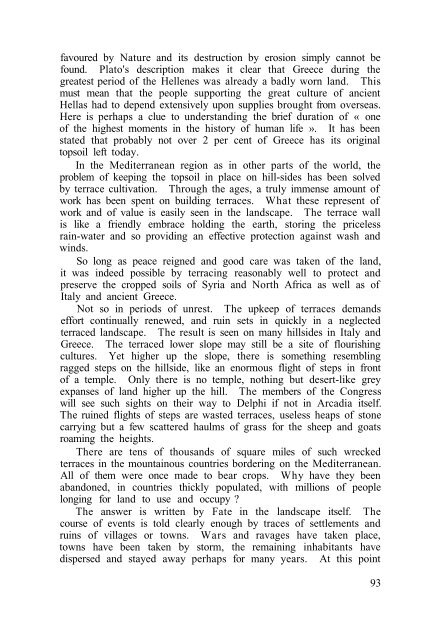septième réunion technique seventh technical meeting ... - IUCN
septième réunion technique seventh technical meeting ... - IUCN
septième réunion technique seventh technical meeting ... - IUCN
- No tags were found...
Create successful ePaper yourself
Turn your PDF publications into a flip-book with our unique Google optimized e-Paper software.
favoured by Nature and its destruction by erosion simply cannot be<br />
found. Plato's description makes it clear that Greece during the<br />
greatest period of the Hellenes was already a badly worn land. This<br />
must mean that the people supporting the great culture of ancient<br />
Hellas had to depend extensively upon supplies brought from overseas.<br />
Here is perhaps a clue to understanding the brief duration of « one<br />
of the highest moments in the history of human life ». It has been<br />
stated that probably not over 2 per cent of Greece has its original<br />
topsoil left today.<br />
In the Mediterranean region as in other parts of the world, the<br />
problem of keeping the topsoil in place on hill-sides has been solved<br />
by terrace cultivation. Through the ages, a truly immense amount of<br />
work has been spent on building terraces. What these represent of<br />
work and of value is easily seen in the landscape. The terrace wall<br />
is like a friendly embrace holding the earth, storing the priceless<br />
rain-water and so providing an effective protection against wash and<br />
winds.<br />
So long as peace reigned and good care was taken of the land,<br />
it was indeed possible by terracing reasonably well to protect and<br />
preserve the cropped soils of Syria and North Africa as well as of<br />
Italy and ancient Greece.<br />
Not so in periods of unrest. The upkeep of terraces demands<br />
effort continually renewed, and ruin sets in quickly in a neglected<br />
terraced landscape. The result is seen on many hillsides in Italy and<br />
Greece. The terraced lower slope may still be a site of flourishing<br />
cultures. Yet higher up the slope, there is something resembling<br />
ragged steps on the hillside, like an enormous flight of steps in front<br />
of a temple. Only there is no temple, nothing but desert-like grey<br />
expanses of land higher up the hill. The members of the Congress<br />
will see such sights on their way to Delphi if not in Arcadia itself.<br />
The ruined flights of steps are wasted terraces, useless heaps of stone<br />
carrying but a few scattered haulms of grass for the sheep and goats<br />
roaming the heights.<br />
There are tens of thousands of square miles of such wrecked<br />
terraces in the mountainous countries bordering on the Mediterranean.<br />
All of them were once made to bear crops. Why have they been<br />
abandoned, in countries thickly populated, with millions of people<br />
longing for land to use and occupy ?<br />
The answer is written by Fate in the landscape itself. The<br />
course of events is told clearly enough by traces of settlements and<br />
ruins of villages or towns. Wars and ravages have taken place,<br />
towns have been taken by storm, the remaining inhabitants have<br />
dispersed and stayed away perhaps for many years. At this point<br />
93
















